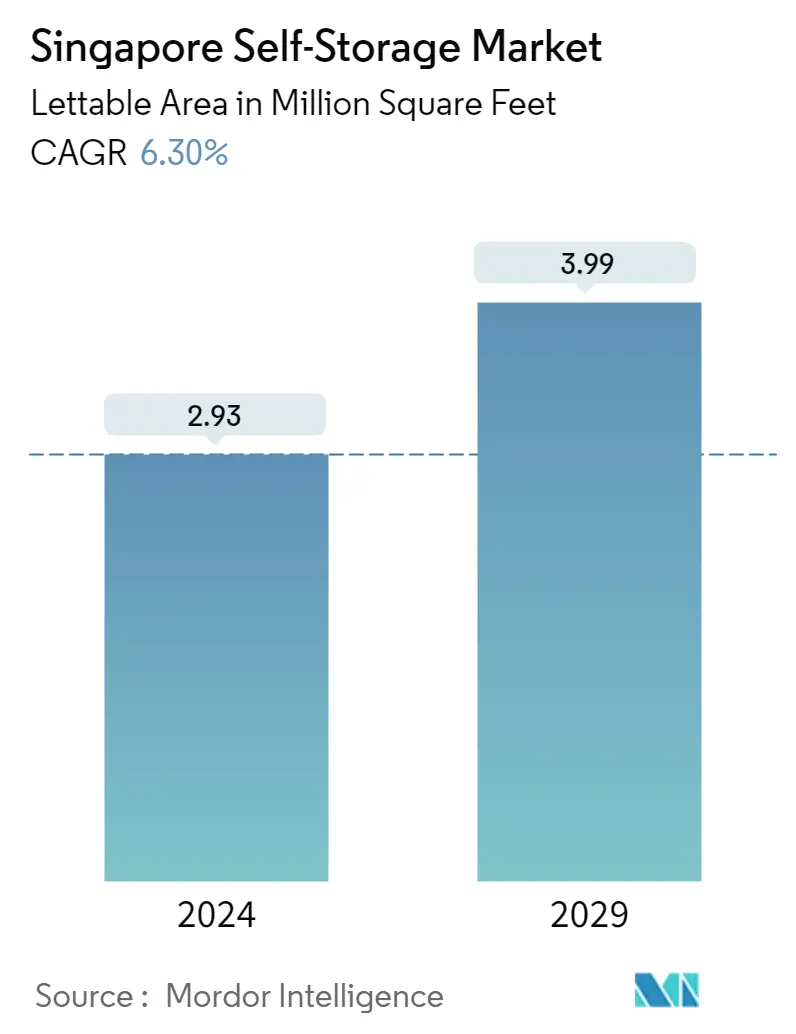Market Size of Singapore Self-Storage Industry

| Study Period | 2019 - 2029 |
| Base Year For Estimation | 2023 |
| Forecast Data Period | 2024 - 2029 |
| Historical Data Period | 2019 - 2022 |
| CAGR (2024 - 2029) | 6.30 % |
| Market Concentration | Medium |
Major Players
*Disclaimer: Major Players sorted in no particular order |
Singapore Self Storage Market Analysis
The Singapore Self-Storage Market size in terms of lettable area is expected to grow from 2.93 Million square feet in 2024 to 3.99 Million square feet by 2029, at a CAGR of 6.30% during the forecast period (2024-2029).
The rise in demand for Singapore's self-storage market is due to increased urbanization and smaller living spaces, which demand self-storage. In addition, the increasing needs of the business segment are also driving the market.
- Singapore has seen a steady increase in the demand for self-storage. The land is becoming increasingly limited, with denser and smaller houses becoming common. As a result, many consumers are looking to self-storage as an accessible answer to their space problems. Land for self-storage has gradually become a commodity due to the rising costs of residential, retail, and industrial real estate over the past few years. The market provides a reasonable option for the public's expanding desire for workspace outside homes and offices.
- Moreover, the requirement for more space for belongings depends on several changes in a consumer's lifestyle, such as moving home, family expansion, and retirement. With rising urbanization and apartments in major Singapore cities gradually getting smaller and more expensive, a significant portion of the country's population is finding they need more room. Self-storage ideas have come up to meet this growing customer need, and as the number of units steadily grows, it's appealing to the people who work in the market.
- According to the Singapore Department of Statistics, in 2021, the population density of Singapore was 7,485 people per square kilometer. The population of Singapore has been increasing over the years within a minimal space, posing challenges such as housing shortages and land scarcity. Such instances further drive the demand for self-storage facilities in the country.
- Demographic change is one factor driving this spike. Many people have been seen relocating from big cities to farther-flung areas. Increases have been made possible by improved occupancy at local stores, which have historically had low rental rates. As a result, rural stores have had a faster growth rate than major metropolitan locations. Such factors are further driving the self-storage market in the country.
- The COVID-19 pandemic drove up demand for self-storage, and some companies started expanding in Singapore. The number of inquiries and takers for these spaces, which individuals and companies hired to store possessions or goods, had increased. More people became aware of the need for more space in their homes for remote work and new interests. Businesses that were reconsidering their office space requirements or stockpiling goods in anticipation of supply chain disruptions were also moving upmarket.
Singapore Self Storage Industry Segmentation
Self-storage facilities give people access to space to rent and store any household or business possessions. Rental agreements for storage space, often known as storage units, are month-to-month agreements. Self-storage allows the user much greater control than full-service storage options, which restrict the customers' access to their possessions and depend on the storage provider to maintain and manage them. The study tracks the key market parameters, underlying growth influencers, and major vendors operating in the industry, which supports the market estimations and growth rates during the forecast period. The study tracks the total lettable area across Singapore. The study provides market trends along with key vendor profiles. The study analyzes the impact of COVID-19 on the ecosystem. The market sizes and forecasts are provided in terms of the number of facilities and total lettable area for all the above segments.
| By Self-storage Type | |
| Personal | |
| Business |
| By Ownership Type | |
| Self-owned | |
| Fully-leased | |
| Hybrid (Partly-leased) |
Singapore Self-Storage Market Size Summary
The self-storage market in Singapore is experiencing significant growth, driven by factors such as urbanization, limited living space, and the increasing needs of the business sector. As the population density rises and residential areas become more compact, individuals and businesses alike are turning to self-storage solutions to manage their space requirements. The market is becoming increasingly attractive as a cost-effective alternative to traditional real estate options, such as renting larger homes or commercial spaces. This trend is further fueled by demographic changes, such as family expansions and relocations, which necessitate additional storage solutions. The COVID-19 pandemic has also contributed to the heightened demand for self-storage, as more people seek to create flexible workspaces at home and businesses reassess their storage needs in response to supply chain disruptions.
The business segment of the self-storage market is poised for substantial growth, driven by the expanding affluent middle class and the rise of e-commerce. Many businesses are opting for self-storage as a more economical and flexible solution compared to traditional warehousing or retail space rentals. The increasing number of startups in Singapore, particularly in the technology and e-commerce sectors, is further propelling the demand for self-storage facilities. These startups benefit from the operational flexibility and cost savings that self-storage offers. The market is moderately competitive, with both global and regional players vying for market share. Companies are focusing on expanding their client base through strategic partnerships and new facility openings, ensuring they remain competitive in the evolving landscape of Singapore's self-storage market.
Singapore Self-Storage Market Size - Table of Contents
-
1. MARKET DYNAMICS
-
1.1 Market Overview
-
1.2 Industry Attractiveness - Porter's Five Forces Analysis
-
1.2.1 Threat of New Entrants
-
1.2.2 Bargaining Power of Buyers/Consumers
-
1.2.3 Bargaining Power of Suppliers
-
1.2.4 Threat of Substitute Products
-
1.2.5 Intensity of Competitive Rivalry
-
-
1.3 Impact of COVID-19 on the Self-Storage Industry in Singapore
-
-
2. MARKET SEGMENTATION
-
2.1 By Self-storage Type
-
2.1.1 Personal
-
2.1.2 Business
-
-
2.2 By Ownership Type
-
2.2.1 Self-owned
-
2.2.2 Fully-leased
-
2.2.3 Hybrid (Partly-leased)
-
-
Singapore Self-Storage Market Size FAQs
How big is the Singapore Self-Storage Market?
The Singapore Self-Storage Market size is expected to reach 2.93 million square feet in 2024 and grow at a CAGR of 6.30% to reach 3.99 million square feet by 2029.
What is the current Singapore Self-Storage Market size?
In 2024, the Singapore Self-Storage Market size is expected to reach 2.93 million square feet.

